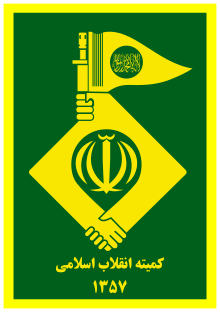
Summary
Islamic Revolution Committees or Committees of Islamic Revolution (Persian: کمیتههای انقلاب اسلامی, romanized: Komitehāye Enqelābe Eslāmi), simply known as the Committee (Persian: کمیته, romanized: Komīte; commonly referred to as Komiteh, pronounced koh-mee-TAY), was a revolutionary organization turned law enforcement agency in Iran. Founded in 1979, it was succeeded by the Guidance Patrol in 2005.[1]
| Islamic Revolution Committees | |
|---|---|
| کمیته انقلاب اسلامی | |
 | |
| Active | 1979–1991 |
| Country | Iran |
| Type | Islamic religious police |
| Role | Law Enforcement |
| Commanders | |
| Notable commanders | Mohammad Reza Mahdavi Kani |
| Insignia | |
| Flag |  |
History edit
Founded as one of Organizations of the Iranian Revolution in 1979, after the overthrow of the Shah they served as substitutes for some of the governmental institutions no longer functioning after the fall of the shah, "such as social services, security, and police".[2] Komiteh were "more widespread and active in cities than rural areas". They were often "located in captured police centers, in the houses of former government officials, and in some public places such as the parliament".[2]
As an arm of Ayatollah Ruhollah Khomeini's network of clerics, they also served as "the backbone of a second power within the state, along with the militia, the army, the revolutionary tribunals", and the wealthy Islamic foundations.[3] Before the Islamic Revolutionary Guard Corps (IRGC) was established in 1979, the komiteh "were responsible for eliminating counterrevolutionary elements within Iran",[2] and worked to eliminate liberal, leftist, and Islamic leftist opposition to Khomeini's power.[4] They have been described (by Gilles Kepel) as much like the Committees of Public Safety of the French Revolution, and served to control the working class supporters of the revolution who made up most of the revolution's mass of demonstrators.[3]
During the Iran-Iraq War, the revolutionary committees also served on the war front.[2]
Following the crushing of opposition, the komiteh turned to "enforcing Islamic regulations on social behavior",[5] hunting down bad hejabi and enforcement of other measures, particularly among the secular middle class.[6] They made
certain that unmarried men and women do not hold hands or walk together on the sidewalk, that storekeepers display in their shops large, glossy photographs of the nation's senior Islamic clerics, that liquor is not served at private parties and that women keep their hair, arms and feet covered, preferably in the black robes called chadors.[5]
Made up of "mostly uneducated, undisciplined revolutionaries",[2] at least as of 1990 they were allegedly more "feared or detested" than any of the other post-revolutionary Iranian government agency.[5]
After the death of Khomeini and "during the first period of Ali-Akbar Hashemi-Rafsanjani's presidency", the police Shahrbani, Gendarmerie, and kominteh were merged, and a new organization, called the "Disciplinary Force" (Niru-ye entezami) or Law Enforcement Command of Islamic Republic of Iran (FARAJA), under the direct control of the Supreme Leader Ali Khamenei, was established in 1991.[7] [2] As of 2005, a branch of FARAJA known as the Guidance Patrol serves as a successor organisation to the Komiteh.[1]
References edit
- ^ a b "Springtime In Iran Means The 'Morality Police' Are Out In Force". NPR. May 3, 2016.
- ^ a b c d e f "KOMITEH". Encyclopedia.com. Retrieved 6 April 2023.
- ^ a b Kepel, Gilles (2002). Jihad : The Trail of Political Islam. Translated by Anthony F. Roberts. Harvard University Press. pp. 113–114.
- ^ Kepel, Gilles (2002). Jihad : The Trail of Political Islam. Translated by Anthony F. Roberts. Harvard University Press. p. 115.
- ^ a b c "In Iran, a Glimpse of Ankle Can Bring Out the Komiteh". The New York Times. New York Times. 16 July 1990. Retrieved 6 April 2023.
- ^ Kepel, Gilles (2002). Jihad : The Trail of Political Islam. Translated by Anthony F. Roberts. Harvard University Press. p. 117.
- ^ Schirazi The Constitution of Iran (1997), p.152


